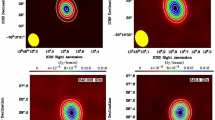Abstract
Details of the observations of a new (second) outburst of the X-ray transientMAXI J1836-194 discovered late in August 2011, a suspected black hole in a low-mass binary system, with the instruments of the SWIFT and INTEGRAL orbiting observatories are presented. The outburst was weaker than the first one; the source had a power-law spectrum in a wide X-ray (0.3–400 keV) energy range without any clear evidence for the presence of a soft (blackbody) component related to the emission from the outer accretion disk regions. This shows that the outburst was a “failed” one: the source did not pass through the sequence of spectral states characteristic of X-ray novae. The observed optical emission from the source whose variability was strongly correlated with its X-ray variability seems to have also been an extension of the power-law spectrum. Spectrum uniformity is, on the whole, unusual for other sources containing a black hole and raises the question about the nature of the emission from MAXI J1836-194 (disk or jet).
Similar content being viewed by others
References
R. A. Arnaud, in Proceedings of the ASP Conference No. 101 on Astronomical Data Analysis Software and Systems V, Ed. by G. Jacoby and J. Barnes, ASP Conf. Ser. (ASP, San Francisco, 1996), Vol. 101, p. 17.
S. D. Barthelmy, L. M. Barbier, J. R. Cummings, et al., Space Sci. Rev. 120, 143 (2005).
D. N. Burrows, J. E. Hill, J. A. Nousek, et al., Space Sci. Rev. 120, 165 (2005).
S. B. Cenko, A. A. Miller, and J. S. Bloom, Astron. Telegram 3614 (2011).
M. Coriat, T. Tzioumis, R. Fender, et al., Astron. Telegram 4038 (2012).
B. T. Draine, Ann. Rev. Astron. Astrophys. 41, 241 (2003).
P. A. Evans, R. Willingale, J. P. Osborne, et al., Astron. Astrophys. 519, A102 (2010).
C. Ferrigno, E. Bozzo, M. Del Santo, and F. Capitanio, Astron. Astrophys. 537, L7 (2012).
N. Gehrels, G. Chincarini, P. Giommi, et al., Astrophys. J. 611, 1005 (2004).
S. A. Grebenev and R. A. Sunyaev, Astron. Lett. 31, 672 (2005).
P. M.W. Kalberla, W. B. Burton, D. Hartmann, et al., Astron. Astrophys. 440, 775 (2005).
J. A. Kennea, E. A. Hoversten, M. H. Siegel, et al., Astron. Telegram 3613 (2011).
H. A. Krimm, S. D. Barthelmy, W. Baumgartner, et al., Astron. Telegram 3966 (2012).
R. Krivonos, M. Revnivtsev, S. Tsygankov, et al., Astron. Astrophys. 519, A107 (2010).
F. Lebrun, J. P. Leray, P. Lavocat, et al., Astron. Astrophys. 411, L141 (2003).
N. Lund, C. Budtz-Jorgensen, N. J. Westergaard, et al., Astron. Astrophys. 411, L231 (2003).
J. C. A. Miller-Jones, G. R. Sivakoff, M. Rupen, and D. Altamirano, Astron. Telegram 3628 (2011).
H. Negoro, M. Nakajima, S. Nakahira, et al., Astron. Telegram 3611 (2011).
J. A. Nousek and D. R. Shue, Astrophys. J. 342, 1207 (1989).
A. Pozanenko, A. Volnova, M. Andreev et al., GRB Coord. Network 12411 (2011).
A. Rau, J. Greiner, and V. Sudilovsky, Astron. Telegram 3619 (2011).
R. C. Reis, J.M. Miller, M. T. Reynolds, et al., Astrophys. J. 751, 34 (2012).
M.G. Revnivtsev, R.A. Sunyaev, D. A. Varshalovich, et al., Astron. Lett. 30, 382 (2004).
P.W. A. Roming, T. E. Kennedy, K. O. Mason, et al., Space Sci. Rev. 120, 95 (2005).
D. M. Russel, T. Belloni, J. C. A. Miller-Jones, et al., Astron. Telegram 3689 (2011).
T. E. Strohmayer and E. A. Smith, Astron. Telegram 3618 (2011).
S. A. Trushkin, N. A. Nizhelskij, and G. V. Zhekanis, Astron. Telegram 3656 (2011).
P. Ubertini, F. Lebrun, G. di Cocco, et al., Astron. Astrophys. 411, L131 (2003).
C. Winkler, T.J.-L. Courvoisier, G. Di Cocco, et al., Astron. Astrophys. 411, L1 (2003).
Y. J. Yang, R. Wijnands, and J. A. Kennea, Astron. Telegram 3975 (2012a).
J. Yang, X. Yonghua, L. Zhixuan, et al., Mon. Not. R. Astron. Soc. 426, L66 (2012b).
Author information
Authors and Affiliations
Corresponding author
Additional information
Original Russian Text © S.A. Grebenev, A.V. Prosvetov, R.A. Sunyaev, 2013, published in Pis’ma v Astronomicheskiĭ Zhurnal, 2013, Vol. 39, No. 6, pp. 415–422.
Rights and permissions
About this article
Cite this article
Grebenev, S.A., Prosvetov, A.V. & Sunyaev, R.A. Second outburst of the black hole candidate MAXI J1836-194 from SWIFT and INTEGRAL observations. Astron. Lett. 39, 367–374 (2013). https://doi.org/10.1134/S1063773713060054
Received:
Accepted:
Published:
Issue Date:
DOI: https://doi.org/10.1134/S1063773713060054




